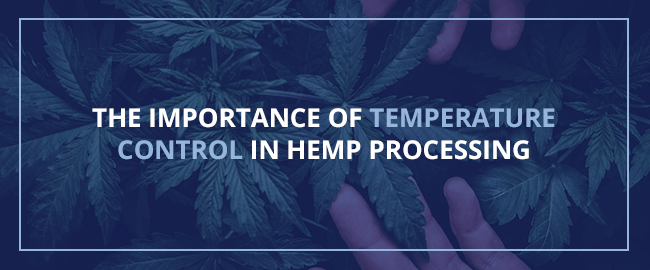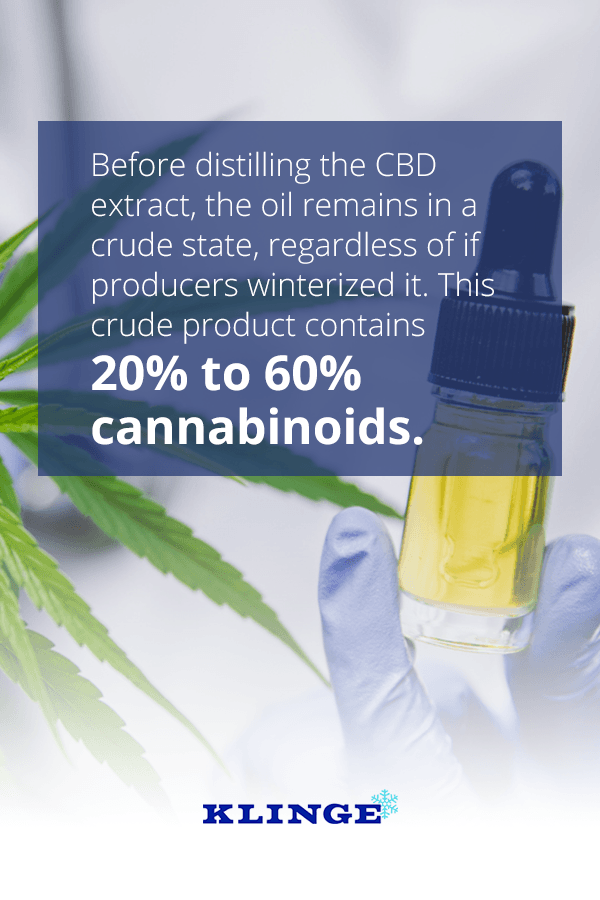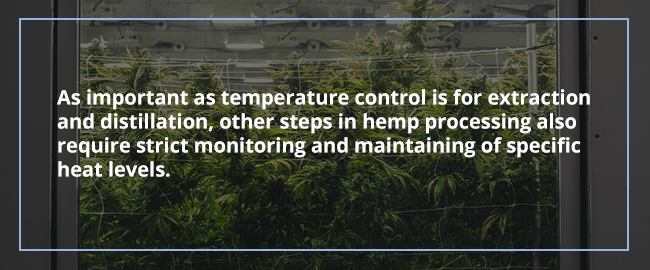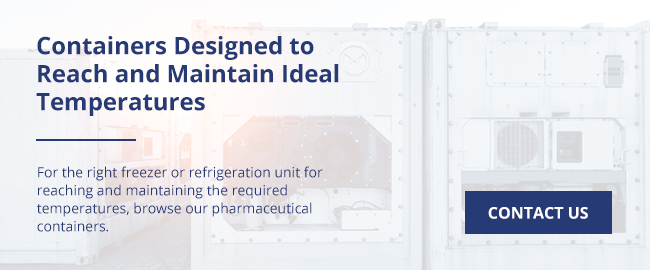The increasing popularity of CBD products and the legalization of industrial hemp by the US government raise the need for equipment for hemp processing. In fact, 50% of the hemp grown across the country ends up as CBD extract. To convert the plants into a concentrate for use in pharmaceuticals and supplements, the facility must carefully control temperatures throughout both extraction and distillation. Poor temperature control will affect the quality of the finished product.
Table of Contents
- Temperature Control CBD Extraction Process
- Temperature Control During the CBD Distillation Process
- Additional Temperature Control Applications for Hemp Processing
Temperature Control CBD Extraction Process
Extraction separates the cannabinoid-containing “crude” oil from the rest of the plant. Depending on the extraction method, this substance can have plant waxes, lipids, and other impurities that most processors seek to remove before it can be used in supplements and other human-grade products.
Producers have several options for extracting the oil from the hemp. These use both polar and non-polar substances (supercritical fluids, solvents, or alcohols) to dissolve cannabinoid compound from the plant. All of the below methods rely on accurately controlling the temperature during the process. Excessive heat during any step of the process can result in the loss of cannabinoids through oxidation.
-
Supercritical Carbon Dioxide Extraction
At room temperature, carbon dioxide takes the form of a gas, but when manipulated to specific temperatures and pressures, it reaches a supercritical state where it moves through material like a gas but dissolves non-polar oils like a liquid solvent.
Supercritical fluid extraction was first utilized by the coffee producers in the food industry for decaffeination of coffee beans and has since been adapted by the hemp industry to safely remove cannabinoids from hemp biomass. This can be done with either just the flowering portion of the plant or the entire plant including the stem, leaves, and seeds if they seek a ‘whole plant extract’.
Cannabinoids readily dissolve into the supercritical carbon dioxide and settles at the bottom of the canisters. After extraction completes, the operator recovers the carbon dioxide for reuse, and opens a tap to recover the ‘crude oil’, while leaving the non-dissolved plant matter behind in the canister. This crude oil is thick and viscous due to other parts of the biomass that were dissolved at the same time, such as plant waxes. The waxes and other un-desired compounds can be removed through further processing like winterization.
Because carbon dioxide is not flammable nor noxious, this method proves safer compared to hydrocarbon extraction, but the overall equipment and operating costs can be higher as well.
-
Pressurized Hydrocarbon Extraction
Using hydrocarbons to extract CBD from hemp is a process that utilizes pressure and heat to condense and evaporate the solvent. Pressurized liquid hydrocarbons help dissolve the needed cannabinoid compounds from the plant material. Solvents used for extracting CBD from hemp include hexane, methylene chloride, butane and methanol, though not all states allow solvent extraction. For instance, Vermont prohibits it.
This process starts with the pressurized liquid solvent mixing with the hemp in an extraction column. After soaking, the operator sends the pressurized liquid through a screen and into a collection tank. The screen filters out solids from the mixture, allowing the combined extract and solvent to move into the collection tank.
The extract will naturally separate as it settles to the bottom of the collection tank while the solvent rises to the top. Heating the collection tank hastens the process, but as with all steps in hemp processing, the temperature cannot reach excessive levels, or it could negatively impact the cannabinoids available in the final product.
After separating from the extract, the pressurized solvent moves to the expansion filter where pressure is reduced to convert it back into a gas. Filters capture any particulate matter as the solvent moves out of the expansion filter and into the recovery container where it is pressurized back into a liquid and stored for use in subsequent extraction batches.
To attain the needed state of liquid or gas, solvents, such as butane, may require temperatures as low as -110 degrees Farhenheit to remain liquid but can rise to 120 degrees Fahrenheit when in gaseous form. Keeping the temperatures of the solvent controlled will ensure it stays in its desired state for drawing as much of the cannabinoid compounds from the hemp as possible.
A closed system such as this that recycles the solvent is safer than open methods that evaporate the flammable solvent into the air. Additionally, recovering the solvent reduces operating costs and enhances the safety of the finished product. Careful control of the extraction process using solvents in a closed-loop system may result in extracts with as little as 200 ppm of hydrocarbons.
Just as with supercritical CO2 Extraction, the resulting ‘crude oil’ will need to be further processed to remove undesirable substances such as plant waxes and lipids.
-
Alcohol Extraction
An alcohol extraction method involves less complicated equipment and can be scaled up as business grows. Typically, producers use ethanol as the alcohol of choice for this process.
In this method, hemp biomass (either flower or whole-plant) is combined with ethanol that has been chilled to -30°C or lower and the vessel and kept at this temperature until the cannabinoids have been dissolved into solution. The timeframe will vary depending on the temperature of the ethanol and the characteristics of the hemp plant and can take anywhere from 30 minutes to several hours. At this point, the residual plant material is physically separated out and the processor is left with an ethanol solution that contains cannabinoids, waxes, and lipids. Chlorophyll and sugars can be drawn out into the solution more so than would occur with a supercritical CO2 or hydrocarbon extraction process, but colder temperatures can mitigate this occurrence.
The waxes and lipids will then need to be removed. This can be achieved by winterization (please see below) and afterwards a large percentage of the alcohol can be reclaimed through rotary evaporation to use in subsequent extractions.
-
Lipid Extraction
Since products with like polarity dissolve each other, fats can dissolve the cannabinoids in hemp. Producers who work on a smaller scale and those producing only edibles may use food-grade lipids such as butter and cooking oil to dissolve the cannabinoids from hemp. Heating hemp with butter or oil to between 240- and 250-degrees Fahrenheit extracts the cannabinoids into the fat. Producers then add the resulting butter or oil into edible products. The resulting product requires testing for potency.
Temperature Control During the CBD Distillation Process
Producers must carefully maintain ideal temperatures to prevent degrading the CBD in the extract. Before distilling the extract, the oil remains in a crude state and contains 20% to 60% cannabinoids. Winterizing removes waxes, fats, and other unwanted polar molecules, while refinement and distillation yields a substance that only contains the desired compound or compounds. The form of refining depends on the extraction method done.
-
Winterization
As the name suggests, this process requires freezing. Depending on the initial extraction method, this is done either as part of the process (in the case of alcohol extraction) or as an additional step to remove impurities from the extracted ‘crude oil’ (in the case of hydrocarbon extraction).
When used as part of the alcohol extraction process, this would occur directly after filtering out pant material that did not get dissolved during alcohol extraction. If used as an additional refinement in a pressurized hydrocarbon extraction, the processor will need to take the ‘crude oil’ from the extraction and mix it with liquid ethanol until it has been fully dissolved. At this point, the winterization process will be the same regardless of the initial extraction method.
The solution is placed into a freezer and chilled down to -40°C or lower. At this temperature, the waxes and lipids come out of solution, forming crystals. The solution can then be poured through a series of filters with decreasing particle size to separate out these crystals from the ethanol solution. To achieve the desired temperatures in a large enough space, producers often find small lab freezers nor grocery store freezers will suffice. Grocery store freezers have the needed size but only reach -18 degrees Celsius, -0.4 degrees Fahrenheit. Lab freezers get cold enough but may be too small. A portable blast freezer may be a solution for these problems (more on that at the end of this article).
The remaining solution can be processed through a rotary evaporator, which reclaims a large percentage of the ethanol for future use, and leaves the processor with a refined cannabinoid oil. At this point the processor can decide if the oil is to be decarboxylated and sold as-is, mixed with other compounds and sold, or processed further to distill and isolate just the CBD compound.
-
Decarboxylation
Most cannabinoid compounds found in the hemp plant have an attached carboxyl group that prevents the human body’s endo-cannabinoid system from being able to use it. This is no different for CBD. To convert the form of CBD extracted from hemp, CBDa, into a more easily absorbed format for human ingestion, producers turn to decarboxylation. While the process naturally occurs over time, decarboxylation happens faster with heat, ensuring a set quantity of CBD in the product. Using heat, this process ”breaks off” the carboxyl group.
Decarboxylation happens at 150 degrees Celsius, 302 degrees Fahrenheit, for 10 minutes, or 140 degrees Celsius, 284 degrees Fahrenheit, for 45 minutes. With such great differences in time for small temperature changes, regulation of the heat during the process is vital to ensuring full decarboxylation and potency of the finished product.
-
Vacuum Distillation
During vacuum distillation, the extract undergoes a high heat process under a vacuum. Temperatures range from 180 to 220 degrees Celsius, 356 to 428 degrees Fahrenheit. The finished product contains 60% to 90% cannabinoids. The heat allows for producers to separate individual compounds from the extract for higher purity.
-
Crystallization
To further concentrate the distilled CBD into an isolate with purities as high as 99.9%, processors use crystallization. The process uses a solvent to dissolve the refined product. Cold temperatures allow the CBD to crystallize into a purified form. The cold temperatures required to separate the CBD after distilling is another form of winterization used for purifying.
The resulting CBD comes in a powder form, but the producer may opt to convert it into a crystal form. Both types are pure, edible CBD without any of the psychoactive effects of THC. In powdered or crystallized form, producers can measure the exact amount of active CBD in the product, allowing for more uniformity in what they sell.
Additional Temperature Control Applications for Hemp Processing
As important as temperature control is for extraction and distillation, other steps in hemp processing also require strict monitoring and maintaining of specific heat levels. Post-harvest handling, chemical preparation, and storage are some of the temperature-sensitive steps encountered in turning hemp into purified CBD oil.
-
Flash Freezing
While some growers dry their plants, the chance for mold growth in the presence of heat or moisture may be too great. Storing hemp at low temperatures reduces the loss of CBD from the plant, which breaks down from heat and oxidation.
To ensure even longer-term storage and quality, flash freezing the hemp soon after harvest preserves the terpenes, which are the essential oils at play, better than drying, which can cause a loss of 40% of terpenes. Flash freezing using liquid nitrogen on a conveyor belt freezes the plants faster, but typically involves more costs in terms of equipment investment, operation, and maintenance than using a standard freezer case that requires extended time for the plants to reach the desired temperature. Alternatively, industrial blast freezers can be used to cool down large quantities of hemp biomass in batches, and may prove to be a more cost-effective method, with the total ‘freeze-time’ being longer than liquid-nitrogen flash-freezing but significantly shorter than standard freezers.
After freezing, the hemp may immediately undergo hydrocarbon or alcohol extraction or remain fresh for drying and carbon dioxide extraction later. Later drying, however, may cause a loss of some terpenes.
For drying, ideal conditions include humidity of 60% and temperatures between 60- and 70-degrees Fahrenheit. Temperatures that are hotter than this may cause the plants to oxidize, reducing the available CBD. Additionally, excessive moisture can promote mold growth, ruining a crop.
-
Hemp Storage and Transport in Dried or Frozen States
For frozen hemp, transporting and storing the products require containers that can maintain subzero temperatures. Allowing the product to thaw and refreeze will degrade the quality. Transportation containers must be portable and have self-contained cooling units to keep the internal temperature well below freezing.
Dried hemp should remain in dry, cold conditions during transport and storage. Heat and moisture can affect the quality of the plant matter by causing CBD oxidation or mold. Maintaining careful control of temperatures during transit and until use will prevent quality problems after harvest in dried hemp.
-
Storing Ethanol
Maintaining temperatures of large volumes of ethanol and ethanol solutions at -30°C and lower requires very powerful freezer units, but most equipment made for these temperatures were originally designed for laboratories and much smaller volumes of fluid.
Fortunately, Klinge Corporation offers freezer equipment for maintaining temperatures down to -70°C and blast freezing down to -60°C. The equipment comes installed into insulated 40 foot long shipping containers, and some of the equipment can also be installed onto existing freezer rooms as well. Provided the facility has permission to store ethanol in a container without explosion proofing, this could be an excellent solution.
Containers Designed to Reach and Maintain Ideal Temperatures
To prevent degradation of the extract and retain the purity of the finished CBD, appropriate temperatures must be maintained throughout hemp processing. Whether freezing hemp immediately after harvest or seeking ways to keep ethanol cold for extraction, producers must use equipment with precision temperature controls. Klinge has several freezer unit designs built into insulated 20’ and 40’-long shipping containers that can be transported by truck, rail, or cargo ship to nearly any destination in the world.
For rapidly bringing temperatures down, you might consider our containerized blast freezer units. For maintaining temperatures either during storage or transport, you can browse our pharmaceutical containers. For more information on finding a unit to meet your hemp processing specifications or to request a quote, please contact us.





